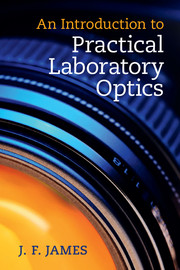Book contents
- Frontmatter
- Contents
- Preface
- 1 Introduction: centred optical systems
- 2 Telescopes and binoculars
- 3 Eyepieces, eyes and colour
- 4 Cameras and camera lenses
- 5 The scientific CCD camera
- 6 Spectrometry
- 7 Interferometers and their uses
- 8 Electro-optical effects and their practical uses
- 9 Microscopes and projectors
- 10 Siderostats and coelostats
- 11 The detection and measurement of radiation
- 12 Practicalities
- Appendix A Gaussian optics
- Appendix B Optical aberrations
- Appendix C A brief introduction to Fourier optics
- Further reading
- Index
9 - Microscopes and projectors
Published online by Cambridge University Press: 05 October 2014
- Frontmatter
- Contents
- Preface
- 1 Introduction: centred optical systems
- 2 Telescopes and binoculars
- 3 Eyepieces, eyes and colour
- 4 Cameras and camera lenses
- 5 The scientific CCD camera
- 6 Spectrometry
- 7 Interferometers and their uses
- 8 Electro-optical effects and their practical uses
- 9 Microscopes and projectors
- 10 Siderostats and coelostats
- 11 The detection and measurement of radiation
- 12 Practicalities
- Appendix A Gaussian optics
- Appendix B Optical aberrations
- Appendix C A brief introduction to Fourier optics
- Further reading
- Index
Summary
Microscopes and projectors have this in common: they illustrate the universal requirement that the passage of light through an instrument must be closely controlled. Neither is likely to be improvised by the reader, but one should understand the way they work.
Projectors
In this section we deal chiefly with the diapositive projector, the old-time ‘magic lantern’ as our Victorian forefathers knew it, which projects images of transparencies on to a large screen for public viewing. Two things are necessary for its design:
(1) it must project a clear sharp image of the transparency on to a distant flat surface, and
(2) it must illuminate the transparency uniformly with light – there must be no dark corners to the picture.
The ingredients for this are a bright source of light, ideally an extended source, but failing that either an array of white LEDs or a filament lamp with a series of coiled filaments as shown in Figure 9.1, arranged so that the space between parallel coils is equal to the width of the coil.
Behind the filament is a spherical mirror placed so that the filament is at its centre of curvature and slightly offset laterally so that the images of each coil fall between the coils themselves.
- Type
- Chapter
- Information
- An Introduction to Practical Laboratory Optics , pp. 116 - 123Publisher: Cambridge University PressPrint publication year: 2014



